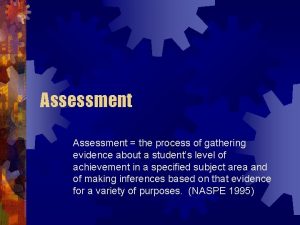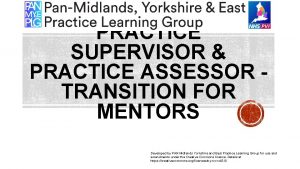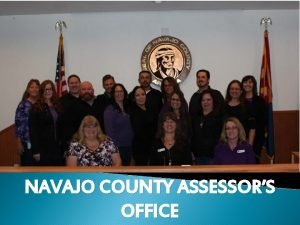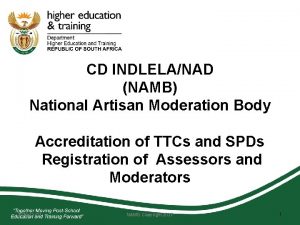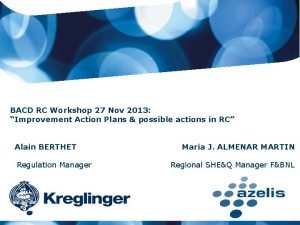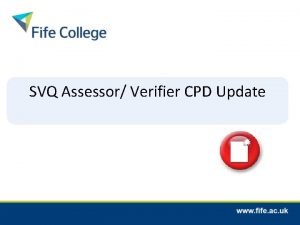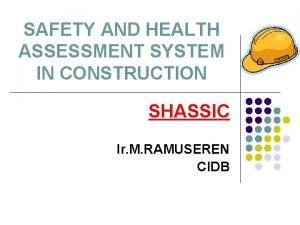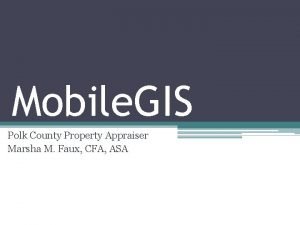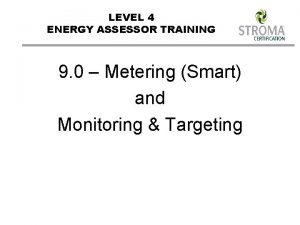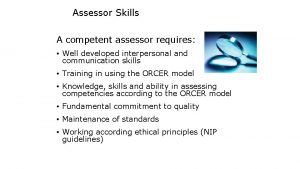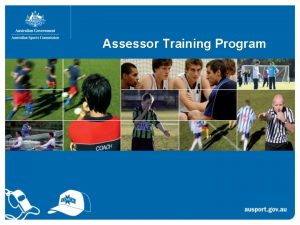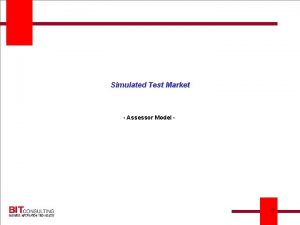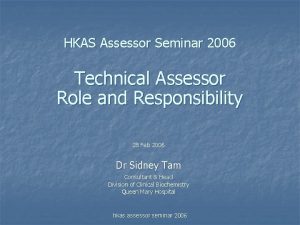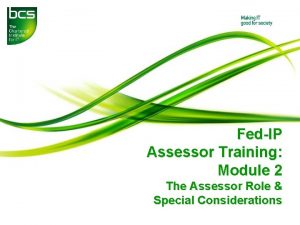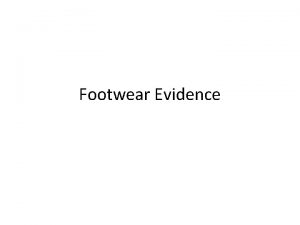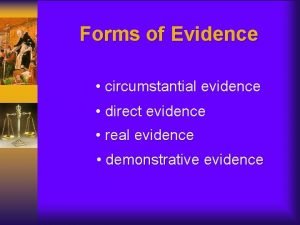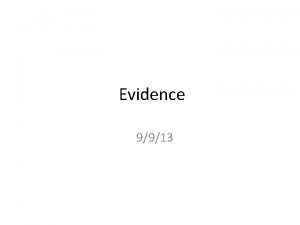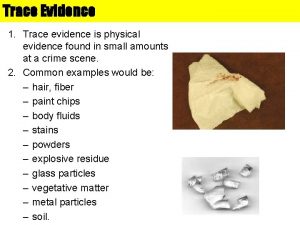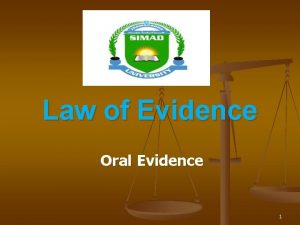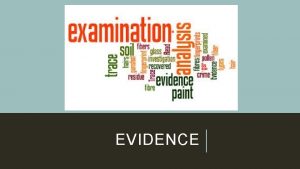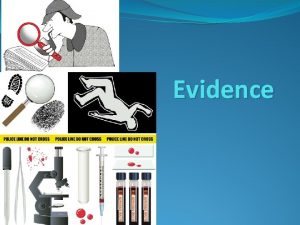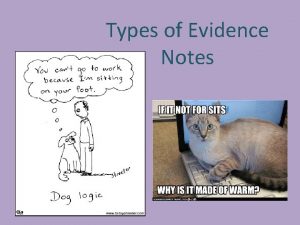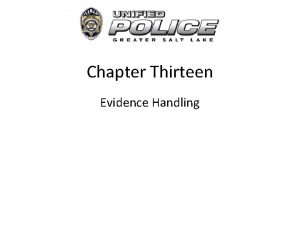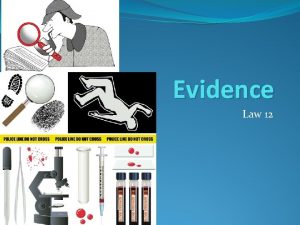The Assessment Process The Assessor Assessment Methods Evidence





















- Slides: 21

The Assessment Process The Assessor Assessment Methods Evidence of Assessment

The Assessor (1) • Assessment decisions for competence based units must be made by an occupationally competent assessor. • RSPH therefore has to be confident that assessors are themselves capable of carrying out all of the requirements of the unit(s) that they are assessing. • Assessors are appointed by the centre, not RSPH.

The Assessor (2) • Assessors should have a recognised qualification in assessment, or • Be working towards one, or • Meet the same standards of assessment practice set out in National Occupational Standards.

Assessment Methods • Observation • Questioning

Observation • Direct observation by the assessor • Witness statements • NB. A witness is not an assessor

Questioning • During an observation • As part of a professional discussion • Questioning of staff providing witness statements • To confirm witness statement with candidate

Question Types • Closed: Yes / No responses • Open: More than 1 word answers, responses to why / how/ what etc. • Follow up: To seek more depth, introduce alternative situations etc. • Hypothetical: What if?

Conduct of Assessment • • Planning Agreement / Dialogue / Candidate / Mentor The visit Who to meet Opportunity Feedback Portfolio / Paperwork Next visit

Planning • Range of activities • Achievement of all learning outcomes • Suitable, verifiable evidence

Agreement Etc • Type of assessment • Type of evidence / how evidence is provided • What is to be assessed • What you expect to be able to see / standard

The Visit • Permission / access • Timely • Mentor, supervisor, authors of witness statements • Colleagues? • Opportunity

Feedback • Positive • Sign-off if possible • What else needs to be done / how candidate improve? • Next visit

Evidence of Assessment • External Verification • Confirm assessor decisions • EV needs to know how assessment decisions arrived at

Possible Evidence • Transcripts • Written Accounts • Brief statement of how witness statements etc provide evidence of assessment • Annotated check-lists • Record of questions and answers • Recordings

Portfolio of Evidence • Cross reference material in portfolio to assessment criteria • Use of Candidate Assessment Summary Forms • Candidate declaration

Make Sure • Evidence is available for ALL assessment criteria. • Candidates can only achieve a learning outcome if all the assessment criteria for that LO are met • Candidates can only pass a unit if all the learning outcomes for that unit are met

Unit APT 3. 6 A: Assist with post mortem examinations • Be able to carry out evisceration and dissection of a deceased person under the direction of supervisory staff: Remove the major organs from the deceased to include: • Heart and great vessels, Lungs, Liver, Spleen, Brain • Remove the major structures from the deceased to include: • Gastro-intestinal tract, Genito-urinary tract

Unit APT 3. 7 Preparation and operation of a mortuary • Be able to store mortuary equipment and materials, by being able to meet the following assessment criteria: • Follow established procedures for the storage of equipment and materials • Retrieve equipment and materials from storage as requested.

Unit APT 3. 8 Prepare for post mortem examinations • Be able to prepare a deceased person for post mortem examination: • Assess risks to self and others that the deceased may present prior to preparing the body for post mortem examination • Establish the identity of the deceased • Ensure information relating to the deceased is made available to the pathologist • Prepare the deceased for post mortem examination according to relevant guidelines

Unit APT 3. 9 Team working • Be able to carry out own role as part of a team: • Organise own work in order to meet agreed aims and objectives on time • Monitor own progress towards meeting aims and objectives • Take appropriate action if aims and objectives are unlikely to be met within agreed timescales • Evaluate own contribution to the work of the team

Unit APT 3. 11 Viewing of the deceased • Be able to provide support to relatives, friends and carers when viewing the deceased : • Confirm the identity of relatives, friends and carers prior to allowing the viewing to take place • Communicate appropriate information in a sensitive manner • Follow established procedures when conducting the viewing of the deceased • Advise relatives, friends and carers appropriately with regard to after death procedures • Refer relatives, friends and carers to additional sources of support and guidance as required.
 Assessment is the process of gathering evidence of
Assessment is the process of gathering evidence of What is a primary source
What is a primary source Primary evidence vs secondary evidence
Primary evidence vs secondary evidence Primary evidence vs secondary evidence
Primary evidence vs secondary evidence Primary evidence vs secondary evidence
Primary evidence vs secondary evidence Primary evidence vs secondary evidence
Primary evidence vs secondary evidence Why are fibers considered class evidence
Why are fibers considered class evidence Class evidence vs individual evidence
Class evidence vs individual evidence How can class evidence narrow a field of suspects
How can class evidence narrow a field of suspects A pair of latex gloves was found at a crime scene
A pair of latex gloves was found at a crime scene Ecological fallacy definition
Ecological fallacy definition Wax pattern in fpd
Wax pattern in fpd Anglia ruskin practice assessor
Anglia ruskin practice assessor Navajo county gis
Navajo county gis Namb assessor registration form
Namb assessor registration form National artisan moderation body
National artisan moderation body Auditor sqas assessor
Auditor sqas assessor Svq assessor training
Svq assessor training Shassic
Shassic Myeplg website
Myeplg website Marsha faux property appraiser
Marsha faux property appraiser Energy assessor training
Energy assessor training
